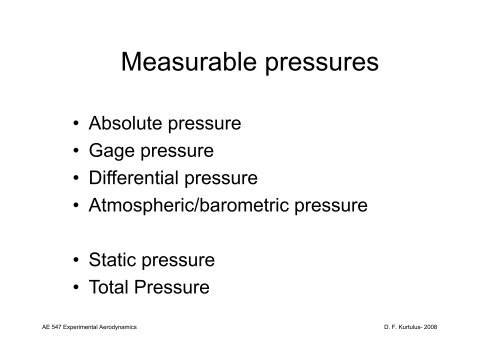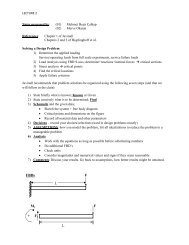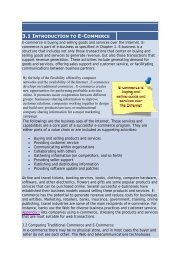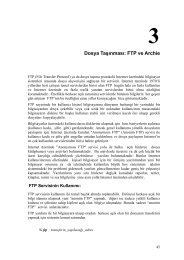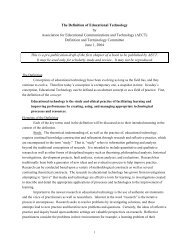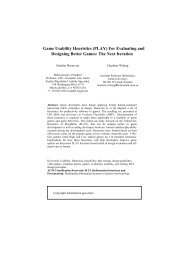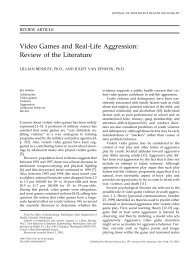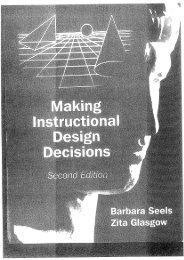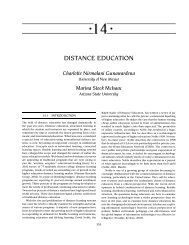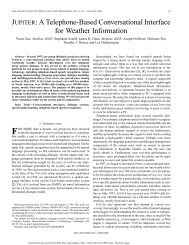Pressure Transducers
Pressure Transducers
Pressure Transducers
Create successful ePaper yourself
Turn your PDF publications into a flip-book with our unique Google optimized e-Paper software.
MMeasurable bl pressures<br />
• Absolute pressure<br />
• Gage pressure<br />
• Differential pressure<br />
• Atmospheric/barometric pressure<br />
• Static pressure<br />
• Total <strong>Pressure</strong><br />
AE 547 Experimental Aerodynamics D. F. Kurtulus- 2008
AE 547 Experimental Aerodynamics D. F. Kurtulus- 2008
<strong>Pressure</strong> Measurement<br />
• Mechanical <strong>Pressure</strong> Measurement<br />
– Manometer<br />
– Mechanical deflection<br />
• <strong>Pressure</strong> Sensitive Paint<br />
– Measures the oxygen concentration in a<br />
polymer paint layer<br />
Static<br />
pressure<br />
p O<br />
~ p ~ c[<br />
02<br />
]<br />
2<br />
Oxygen<br />
Partial<br />
pressure<br />
Henry’s Constant x<br />
oxygen concentration<br />
AE 547 Experimental Aerodynamics D. F. Kurtulus- 2008
AE 547 Experimental Aerodynamics D. F. Kurtulus- 2008
The method is based on the phenomenon p<br />
of deactivation of<br />
photoexcieted molecules of organic luminosphores by oxygen<br />
molecules (quenching).<br />
The ability of oxygen to quench the luminescence of organic<br />
luminophores was discovered by HH. Kautsky and HH. Hirsch in<br />
1935.<br />
Certain materials are luminous when excited by the correct<br />
light wavelength.<br />
This luminescence can be quenched by the addition of<br />
another material. material<br />
The luminescence is dependent p on air ppressure.<br />
AE 547 Experimental Aerodynamics D. F. Kurtulus- 2008
A pressure sensitive paint consists of a dye held in an oxygen permeable<br />
binder. The dye y absorbs light, g , and the energy gy is used to shift an electron from<br />
one part of the molecule to another.<br />
The former part of the molecule gains a positive charge with a negative charge<br />
on the latter and these are stabilized and held apart.<br />
For pyrene based paints, the excitation wavelength is in the ultraviolet (UV,<br />
λ=340nm) and the emission wavelength is in the blue (λ =450nm)<br />
AE 547 Experimental Aerodynamics D. F. Kurtulus- 2008
• These rubbers contain powerful adhesives that bind to<br />
many substances (so that they are easily binded to the<br />
aerodynamic model)<br />
• Th They are highly hi hl permeable bl to oxygen.<br />
•Distribution of oxygen in the paint layer is detected.<br />
AE 547 Experimental Aerodynamics D. F. Kurtulus- 2008
Bi Binder d example: l<br />
AE 547 Experimental Aerodynamics D. F. Kurtulus- 2008
AE 547 Experimental Aerodynamics D. F. Kurtulus- 2008
AE 547 Experimental Aerodynamics D. F. Kurtulus- 2008
Oxygen concentation is detected by CCD cameras<br />
AE 547 Experimental Aerodynamics D. F. Kurtulus- 2008
<strong>Pressure</strong> <strong>Transducers</strong><br />
<strong>Pressure</strong> (input) Motion (output)<br />
(A physical effect)<br />
AE 547 Experimental Aerodynamics D. F. Kurtulus- 2008
<strong>Pressure</strong> sensing elements<br />
The basic pressure sensing<br />
elements l t can bbe configured fi d<br />
as:<br />
(A) a CC-shaped shaped Bourdon tube<br />
(B) a helical Bourdon tube<br />
(C) flat diaphragm<br />
(D) a convoluted diaphragm<br />
(E) a capsule<br />
(F) a set of bellows<br />
A pressure transducer might<br />
combine the sensor element with<br />
a mechanical-to-electrical<br />
or mechanical-to-pneumatic<br />
converter and a power supply.<br />
AE 547 Experimental Aerodynamics D. F. Kurtulus- 2008
<strong>Pressure</strong> sensing elements<br />
AE 547 Experimental Aerodynamics D. F. Kurtulus- 2008
Classification of electrical pressure transducers<br />
There are basicallyy two general g types yp of electrical transducers:<br />
- 1. Active devices: the physical effect to be identified produces an electrical<br />
quantity, e.g. a voltage.<br />
Typical examples are piezo-electric transducers, thermocouples, etc.<br />
Their sensitivity is expressed as the ratio of the change of electrical output to<br />
the change of physical input.<br />
S= S ∆V/ ∆p<br />
Their typical overall accuracy is of the order of 1%.<br />
AE 547 Experimental Aerodynamics D. F. Kurtulus- 2008
Classification of electrical pressure transducers<br />
2. Passive devices:<br />
-Cannot do anything by themselves. There has to be an external power<br />
source (voltage) so that the device can be activated.<br />
-an electrical circuit element (R,L,C) is modified by the physical effect<br />
(input pressure or voltage).<br />
-The sensitivity of passive transducers is expressed as the ratio of the relative<br />
impedance variation ∆Z/Z to the change of physical input.<br />
S= (∆Z/Z) / ∆p<br />
Typical yp examples p are resistive, inductive and capacitive p transducers.<br />
Their typical overall accuracy is also of the order 1%.<br />
dI 1<br />
V = RI V = L V = ∫ I dt<br />
R = RI VL = L VC =<br />
dt ∫ I dt<br />
C<br />
C<br />
ε<br />
∼<br />
L<br />
AE 547 Experimental Aerodynamics D. F. Kurtulus- 2008<br />
R
Classification of electrical pressure transducers<br />
Electrical transducers can also be classified accordingg to their modulation<br />
mode.<br />
-continuous mode (DC): the analog output is a DC signal; proportional to the<br />
input signal.<br />
-amplitude amplitude modulation (AM): the output signal is an AC signal; its amplitude<br />
is a function of the measured quantity whereas its frequency is constant.<br />
-frequency modulation (FM): the output signal is an AC signal; its frequency<br />
iis afunction f ti off th the measuredd quantity tit whereas h it its amplitude lit d iis constant. t t<br />
AE 547 Experimental Aerodynamics D. F. Kurtulus- 2008
Alternating current (AC current)<br />
Alt Alternating ti CCurrent t (AC) fl flows one way, th then th the other th way, continually ti ll<br />
reversing direction.<br />
An AC voltage is continually changing between positive (+) and negative ( (-). )<br />
The rate of changing direction is called the frequency of the AC and it is<br />
measured in hertz (Hz) which is the number of forwards forwards-backwards backwards cycles per<br />
second.<br />
AC from a power supply(sine wave)<br />
An AC supply is suitable for<br />
powering some devices such<br />
as lamps and heaters but<br />
almost all electronic circuits<br />
require a steady DC supply<br />
AE 547 Experimental Aerodynamics D. F. Kurtulus- 2008
Alternating current (AC current)<br />
• Current which varies sinusoidally in time is called alternating current (AC)<br />
as opposed to direct current (DC).<br />
The symbol ~ is used to denote an AC source. In general a source<br />
means either a source of alternating current or voltage.<br />
υ = V cosωt<br />
for alternating<br />
voltage, V = voltage amplitude<br />
i = I cos ωω<br />
t for alternatin g current current, I = current amplitude<br />
• In the U.S. and Canada, commercial electric-power distribution system<br />
uses a frequency of f = 60 Hz, corresponding to ω = 377 rad/s. In much<br />
of the rest of the world uses f = 50 Hz. In Japan, however, the country is<br />
divided in two regions with f = 50 Hz and 60 Hz.<br />
AE 547 Experimental Aerodynamics D. F. Kurtulus- 2008
Direct Current (DC current)<br />
A DC voltage is always positive (or always negative), but it may increase and<br />
decrease.<br />
Electronic circuits normally require a steady DC supply which is constant at one<br />
value or a smooth DC supply which has a small variation called ripple.<br />
Cells, batteries and regulated power supplies provide steady DC which is ideal<br />
ffor electronic l t i circuits. i it<br />
Steady DC (from a battery or regulated power supply,<br />
this is ideal for electronic circuits)<br />
Smooth DC (from a smoothed power supply,<br />
this is suitable for some electronics)<br />
AE 547 Experimental Aerodynamics D. F. Kurtulus- 2008
Different Types of <strong>Pressure</strong> <strong>Transducers</strong><br />
<strong>Pressure</strong> is a force acting on a surface. It is usually measured as a force per unit area.<br />
P<strong>Pressure</strong> ttransducers d can also l bbe classified l ifi d according di tto th the ttype of f pressure measured. d<br />
-the gage pressure transducer: it measures pressure referenced to local atmospheric<br />
pressure and is vented to atmosphere. When its pressure port is exposed to atmosphere,<br />
the transducer indicates a zero output.<br />
-the absolute pressure transducer: it measures pressure referenced to an internal<br />
chamber h b sealed l dat t0P 0 Pascal. l When Wh its it pressure port ti is exposed dt to the th atmosphere, t h the th<br />
transducer indicates local atmospheric pressure.<br />
-the the differential pressure transducer: it measures the difference between two pressures<br />
applied to its pressure ports.<br />
-the sealed pressure transducer: it measures pressure referenced to an internal<br />
chamber, h b sealed l d at t a given i pressure<br />
AE 547 Experimental Aerodynamics D. F. Kurtulus- 2008
Different Types of <strong>Pressure</strong> <strong>Transducers</strong><br />
As many other instruments, the transducer is affected by its environment.<br />
The accuracy y of its output strongly gy depends upon a correct calibration as<br />
well as upon the conditions in which it is used.<br />
In general, great care must be taken with respect to:<br />
-the transducer operating temperature<br />
-its reference pressure<br />
-electrical and magnetic fields eventually present<br />
-mechanical h i l vibrations ib ti<br />
A correct selection of the transducer to be used in a particular p application pp<br />
requires a correct knowledge of<br />
-its pressure sensitivity,<br />
-its range, g<br />
-its frequency response or resonant frequency<br />
-its sensitivity to acceleration, etc…<br />
AE 547 Experimental Aerodynamics D. F. Kurtulus- 2008
Variable capacitance transducers<br />
The capacitance p is ggiven by y the equation: q<br />
C<br />
=<br />
KS(<br />
N −1)<br />
d<br />
C: capacitance<br />
K: dielectric constant of the material between the plates<br />
S: Area of one side of one plate<br />
N: Number of plates<br />
d: distance between two adjacent plates<br />
A capacitance p transducer operates p on the pprinciple p that the pphysical y pproperty p y to be sensed<br />
changes one of the variables in the above equation (usually the distance d) which then<br />
changes the capacitance C.<br />
If the distance d is modified modified, such transducer is in fact a displacement transducer transducer, but it is<br />
also used to measure force, pressure and acceleration.<br />
AE 547 Experimental Aerodynamics D. F. Kurtulus- 2008
Example: p<br />
Variable capacitance transducers<br />
This capacitance transducer is used to<br />
determine the level of liquid hydrogen.<br />
The capacitance between the central<br />
rod and the surrounding tube varies with<br />
the changing dielectric constant KK,<br />
varying because of the changing liquid<br />
level.<br />
C<br />
=<br />
KS(<br />
N −1)<br />
d<br />
Capacitance pickup for determining<br />
level of liquid hydrogen<br />
C: capacitance<br />
K: dielectric constant<br />
S: Area of one side of one plate p<br />
N: Number of plates<br />
d: distance between two adjacent plates<br />
AE 547 Experimental Aerodynamics D. F. Kurtulus- 2008
Variable capacitance transducers<br />
A classical type of capacitive transducer for pressure measurements:<br />
Variable Capacitance<br />
<strong>Pressure</strong> Transducer<br />
The gap is small<br />
(of order 0.05 mm)<br />
A diaphragm is suspended between two<br />
parallel metallic plates in order to form two<br />
capacitances C1 and C2 C2.<br />
The capacitance will change their value<br />
according to the diaphragm deflection due to a<br />
pressure difference between its two sides.<br />
This type of transducers is mostly used to<br />
measure small changes of a fairly low static<br />
pressure.<br />
AE 547 Experimental Aerodynamics D. F. Kurtulus- 2008
Capacitance <strong>Pressure</strong> Transducer<br />
AE 547 Experimental Aerodynamics D. F. Kurtulus- 2008
Variable resistance transducers<br />
The resistance of a conductor is given by:<br />
l<br />
R = ρ<br />
S<br />
R: resistance<br />
ρ: thermal resistivity of the resistance material<br />
l : length of the conductors<br />
S: cross sectional area of the conductors<br />
A resistive transducer operates on the principle that the physical property to be<br />
sensed changes one of the variables in the above equation equation.<br />
The simplest of these devices is the ordinary switch.<br />
Another type is a sliding contact resistive transducer: it converts a mechanical<br />
displacement into an electrical output, either voltage or current. This is<br />
accomplished by changing the length of the conductor conductor.<br />
AE 547 Experimental Aerodynamics D. F. Kurtulus- 2008
Variable resistance transducers<br />
There are basically two types of variable resistance pressure<br />
measurements:<br />
-<strong>Transducers</strong> which detect large resistance changes usually<br />
operate in potentiometer circuits. circuits<br />
-<strong>Transducers</strong> which detect small resistance changes are used in<br />
bridge circuits (strain gage transducers are a classical example)<br />
AE 547 Experimental Aerodynamics D. F. Kurtulus- 2008
Potentiometric pressure transducer:<br />
Variable resistance transducers<br />
The e bas basic c operating ope a g principle p c p e of o a potentiometer po e o e e circuit c cu pressure p essu e transducer a sduce is s sshown o in Figure. gu e<br />
This device consists of a capsule, a sliding contact wiper and the resistance wire winding.<br />
•The pressure to be measured is applied to the capsule which, through a linkage rod,<br />
moves a sliding contact (wiper) across the electrical resistance wire windings.<br />
•The Th movement t of f the th wiper i arm across th the potentiometer t ti t converts t the th mechanically h i ll<br />
detected sensor deflection into a resistance measurement<br />
AE 547 Experimental Aerodynamics D. F. Kurtulus- 2008
Strain gage transducer:<br />
Variable resistance transducers<br />
A strain s a gage transducer a sduce transforms a s o s a deformation de o a o (or (o a micro-displacement) codspace e ) intoo a<br />
resistance variation.<br />
By using 2 or 3 gages, the components of the local deformation can be obtained.<br />
Several types yp of strain ggage g ppressure<br />
transducers are:<br />
1. Gaged diaphragm pressure transducers<br />
2. Cantilever type transducers<br />
33. EEmbedded b dd d strain t i gage ttransducers d<br />
4. Unbounded strain gage transducers<br />
AE 547 Experimental Aerodynamics D. F. Kurtulus- 2008
Strain gage transducer:<br />
1. Gaged diaphragm pressure<br />
transducers:<br />
Variable resistance transducers<br />
Th They contain t i a di diaphragm h with ith<br />
strain gages bounded directly to<br />
the surface.<br />
When pressure is applied to the<br />
surface, the diaphragm deflects<br />
and the resistance of the strain<br />
gages change.<br />
AE 547 Experimental Aerodynamics D. F. Kurtulus- 2008
Strain gage transducer:<br />
2. Cantilever type transducers:<br />
These transducers consist of a<br />
pressure velocity l it element l t<br />
connected through a linkage rod<br />
to some type of cantilever<br />
instrumented with strain gages gages.<br />
The most frequently used types<br />
of pressure collecting elements<br />
are diaphragms, capsules and<br />
bellows.<br />
Variable resistance transducers<br />
The most common application of<br />
these devices is for low pressure<br />
measurements.<br />
Bounded strain gage cantilever type transducers<br />
AE 547 Experimental Aerodynamics D. F. Kurtulus- 2008
Strain gage transducer:<br />
3. Embedded strain gage<br />
transducers:<br />
Variable resistance transducers<br />
GGenerally, ll th the embedding b ddi<br />
material is an epoxy resin which<br />
transmits the strain when a<br />
uniaxial pressure is applied applied.<br />
The strain gage then provides a<br />
proportional resistance change change.<br />
Generally embedded strain gage<br />
transducers are very small small.<br />
They are useful for high pressure<br />
environments where a fast time<br />
response is required.<br />
Embedded strain gage transducers<br />
AE 547 Experimental Aerodynamics D. F. Kurtulus- 2008
Strain gage transducer:<br />
Variable resistance transducers<br />
4. Unbounded strain gage g g pressure p<br />
transducers:<br />
They operate on the same principle as<br />
bounded strain gage transducers: the<br />
electrical resistance of a .wire varies with<br />
strain changes.<br />
In the device, the wires are strung on<br />
electrical insulating pins, one of which is<br />
on a fi fixed d fframe andd one off which hi h iis<br />
ona<br />
movable armature.<br />
Under pressure pressure, the diaphragm<br />
elongates moving the armature, then<br />
causing the strain gages to produce a<br />
change in electrical resistance resistance.<br />
Unbounded strain gage transducers<br />
AE 547 Experimental Aerodynamics D. F. Kurtulus- 2008
Variable inductance transducers<br />
Inductive transducers operate on the principle that the voltage drop across a coil<br />
which produces a magnetic g field is proportional to the rate of change g of current<br />
with respect to time.<br />
V Va L =<br />
dI<br />
= − L I : current<br />
dt<br />
2<br />
N<br />
l i l<br />
+<br />
μS<br />
S<br />
i<br />
a<br />
a<br />
V a : applied voltage<br />
t : time<br />
L : inductance<br />
N: number of windings in the coil<br />
li,la: length of iron circuit and air gaps<br />
Si,Sa: cross sectional area of iron circuit and air gaps<br />
μ : permeability bilit of f magnetic ti material<br />
t i l<br />
Coil which<br />
produce a<br />
magnetic field<br />
pressure<br />
A simple self-inductance arrangement wherein<br />
a change in the air gap changes the output.<br />
AE 547 Experimental Aerodynamics D. F. Kurtulus- 2008
Piezoelectric transducers<br />
The piezoelectric effect is the ability of a material to generate an electrical<br />
potential when subjected to a mechanical strain.<br />
This is the ability of a material to change dimensions when subject to a<br />
voltage.<br />
Some materials which exhibit these characteristics are:<br />
Quartz, Rochelle salt, ammonium dihydrogen phosphate and even ordinary<br />
sugar sugar.<br />
One problem with these devices is that very sophisticated technology is<br />
required for the manufacture of piezoelectric sensors sensors.<br />
AE 547 Experimental Aerodynamics D. F. Kurtulus- 2008
Pi Piezoelectric l t i P<strong>Pressure</strong> TTransducer d<br />
Only for<br />
Unsteady<br />
Measurements<br />
Kulite Transducer<br />
Used in shock tube<br />
AE 547 Experimental Aerodynamics D. F. Kurtulus- 2008
P<strong>Pressure</strong> System S Response R Ti Time<br />
Flush Mounted Transducer<br />
Maximum performance<br />
Diaphragm Time response depends on<br />
Volume Change<br />
Friction in Tube<br />
Tubing<br />
Acceleration of<br />
fluid and diaphragm<br />
Compressibility of fluid<br />
Cavity<br />
AE 547 Experimental Aerodynamics D. F. Kurtulus- 2008


